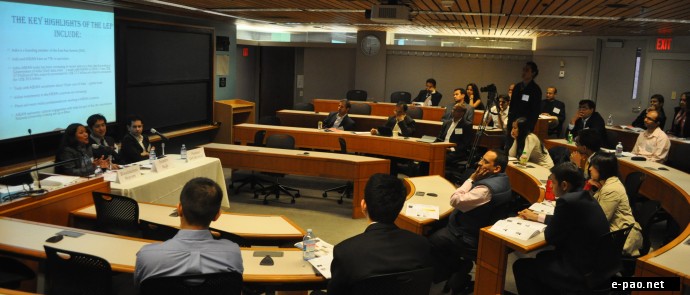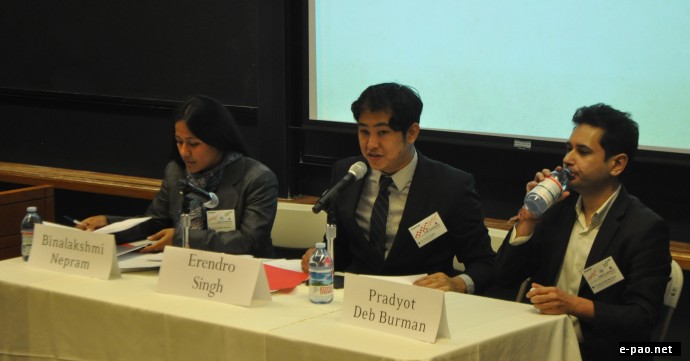Harvard India Conference on Look East Policy: Look East Through The Northeast
25th March 2012, Boston:

>Panelist at Harvard India Conference on Look East Policy: Look East Through The Northeast
Harvard India Conference
Look East Policy: Look East Through The Northeast
Harvard Business School and Harvard Kennedy School, USA organized the 9th annual Harvard India Conference on the 24th and 25th of March 2012 at their campus in Boston. The theme of this year's conference was "India – The Next Frontier." Among many important panels, the conference also featured a panel titled "Look East Policy: Look East Through The Northeast." The panel on the Look East Policy included Leichombam Erendro Singh, a World Bank Fellow at Harvard University, Pradyot Deb Burman, Chairman and Editor, The Northeast Today Magazine, and Binalakshmi Nepram, Writer-Activist, Founder, Manipur Women Gun Survivors Network.
THE MANIPUR INTERNATIONAL CENTER, a research and advocacy group based in Boston, USA sponsored the panel. The Center is a non-partisan, non-sectarian, and not-for-profit organization that promotes peace and development initiatives in Manipur and the Northeastern Region of India.
In 1991, coinciding with the liberalization of India's economy, Look East Policy signaled a major shift in India's foreign policy by asserting itself as an important economic, and strategic player in Asia. Connecting India to South East Asia is the North Eastern Region of India (NER). The NER is an important focal point that is tied to the achievement of many Look East Policy objectives. While the region's strategic location and untapped natural resources suggest abundant potential for India, insurgency and conflict in the region are some of India's biggest challenges today. How can India confront these challenges and realize existing opportunities? These were the backdrops of the panel discussion.
Leichombam Erendro Singh, after giving a brief background on India's Look East Policy and it's dramatic increase in the volume of trade with other Asian economies, argued that although the country's economy has picked up significant momentum since the liberalization, the NER has benefitted little "spillover effects" from this economic surge because of the region's landlocked nature, among many others. He argued that inspite of India's 10% earmark spending the abysmal state of infrastructure in the region remains one of the most difficult "binding constraints." He emphasized a "big push" spending to break the infrastructural handicap of the region rather than marginal spending that may fail to hit the "impact horizon."
He also decried the lack of focused efforts in this landlocked region from important central ministries and their "unspent funds" flowing into the Non-Lapsable Central Pool of Resources (NLCPR) in the last decade or so. Erendro also called for a broad restructuring, redefinition, and greater empowerment of the Ministry of Development of the Northeastern Region ( MDoNER ) such that the department is better equipped to avoid operational inefficiency, to fix major leakages, and to incentivize the other central departments to target infrastructure development in the region with greater urgency, and coordination.
He also argued that the imposition of unconstitutional laws such as the AFSPA 1958 on a citizenry for more than half a century is not only inhumane, but is also an example of the "tyranny of the majority," that results from the absence of proper "separation of powers" in the current Indian Parliamentary System, and called for an empowered Rajya Sabha, fashioned similar to the US Senate. He also emphasized the need for the Indian government to shift its NER regional policy from that of security obsession that he termed as "anger management for provisional expediency," to a long-term sustainable approach of giving "greater political, economic, and cultural self-determination" to the people of the Northeast. Answering to a question from the audience, Erendro referred to Irom Sharmila's 11 years long hunger strike against AFSPA in Manipur and concluded "such a spirit, which epitomizes the region's resilience, can not be crushed by force."

>Panelist at Harvard India Conference on Look East Policy: Look East Through The Northeast
Binalakshmi Nepram in her presentation revisited the origins of the Look East Policy in the early 1990s. She described the policy as an attempt by India to strengthen its relationship with ASEAN members. As a result of this effort, India-ASEAN trade has been increasing in recent years, constituting 10% of India's global trade in 2011. She argued that the Look East Policy needs re-examination, however, because it has not been able to address the economic turn around of the NER as it should have. She revisited the argument that there has been a prolonged stagnation in the region for the last four decades and cast doubt on the India's regional industrial development strategy, and lamented its inability to produce tangible results. Other challenges such as ethnic tensions, extortion, economic blockades, bandhs, large military presence, and armed insurgency further compound the problem in the region.
She also emphasized the relevance of the North Eastern Region Vision 2020 document, and threw light on the basic strengths of the region that include the presence of large natural resources, mineral deposits, and tremendous hydropower potential. She also spoke about the prospects of tourism, handicrafts, agro-based industries, and a relatively literate population in the region. Binalakshmi also highlighted the presence of community spirit, and traditional system of governance as has always existed in the NER. She also spoke about the strategic border towns of Moreh in Manipur, and Champhai in Mizoram, and their potential to be the gateways to Southeast Asia.
At the concluding section of her talk, she reiterated the importance of including women's involvement in economic development planning and activities, and gave the example of Manipur's Ema Keithel, or the women's only market in Manipur, as an effective economic, social, and political empowerment model. Doing so she drew parallels between the women led markets in Laos, Vietnam, and Thailand and that of Manipur and some other parts of Northeast India. Emphasizing that such similarities between the NER and Southeast Asia can be harnessed for a more meaningful economic cooperation under the Look East Policy, Binalakshmi pointed out that these critical aspects are missing both in the document North Eastern Region Vision 2020, and Look East Policy planning and implementation.
The final speaker of the panel, Pradyot Deb Burman, stated that it is not industrialization that should be the way for Northeast India. He spoke about the need for self-sufficiency efforts, for example in food grains sector. He mentioned that "the Northeast can be the food bowl of the East." He also pointed out the misaligned incentive structure created for manufacturing industries in the Northeast. As an illustration he brought up an example of some factories infiltrating his state of Tripura that provides poor quality jobs, and deeply disturb the local economy. He decried the region's inability to attract better job producing, environment protecting, and income generating ventures.
According to him Look East Policy is flawed and the Northeast India 2020 is an "incomplete document" as it did not consult the actual stakeholders in the region. Pradyot also pointed out that some of the high potential businesses in the Northeast include tourism, hospitality industry, power generation, and cited the India's Milk Revolution as a workable model that incorporated collective planning and involvement of local communities.
The Look East Policy panel was participated and well received by a very engaging group of scholars, professionals, bureaucrats, media, and entrepreneurs from the United States, India, and around the world. Close to 800 participants attended the two-day Harvard India Conference that concluded today. It is one of the largest conferences of its kind in the US
No comments:
Post a Comment